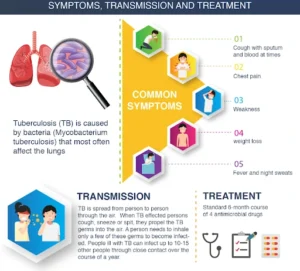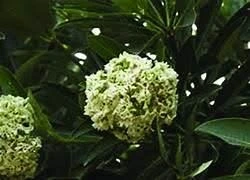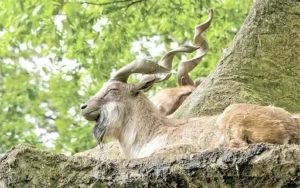UPSC GS 1
Global Tuberculosis (TB) Report 2024
- News: The World Health Organization (WHO) released its Global TB Report 2024 recently.
- Publisher: The Global TB Report is an annual publication by the World Health Organization (WHO).
- Scope: The report offers a detailed, up-to-date analysis of the global tuberculosis (TB) epidemic, tracking advancements in TB prevention, diagnosis, and treatment at global, regional, and national levels.
- Highlights of the 2024 Report:
-
- Record High TB Cases: In 2023, 8.2 million people were newly diagnosed with tuberculosis, marking the highest number of cases since the WHO began monitoring TB globally in 1995. This is a sharp rise from the 7.5 million new cases reported in 2022.
- TB Deaths vs. COVID-19: Although the number of TB deaths in 2023—estimated at 1.25 million—is lower than the 1.32 million deaths in 2022, TB fatalities still greatly exceed the 320,000 COVID-19 deaths reported to the WHO last year.
- Global Burden: A total of 30 low- and middle-income countries (LMICs) account for 87% of the global TB burden. Five countries—India (26%), Indonesia (10%), China (6.8%), the Philippines (6.8%), and Pakistan (6.3%)—combine to hold 56% of the global TB cases.
- Demographic Distribution: Among those diagnosed with TB, 55% were men, 33% were women, and 12% were children and young adolescents.
- Key Risk Factors: The report identifies five major risk factors driving new TB cases: undernutrition, HIV infection, alcohol use disorders, smoking, and diabetes.
- India’s TB Scenario in 2023: India reported an estimated 27 lakh TB cases in 2023, with 25.1 lakh individuals diagnosed and put on treatment, boosting the country’s treatment coverage to 89% in 2023, up from 72% in 2015.
- Decline in TB Incidence: India has seen a reduction in its TB incidence, from 237 cases per lakh population in 2015 to 195 per lakh population in 2023, reflecting a 17.7% decline in cases.
-

- Tuberculosis (TB)
- Definition: Tuberculosis (TB) is a bacterial infection spread through inhaling tiny droplets from the coughs or sneezes of an infected person.
-
- TB is caused by a bacterium called Mycobacterium tuberculosis, belonging to the Mycobacteriaceae family.
- Worldwide, TB is the 13th leading cause of death and the second leading infectious killer after COVID-19 (above HIV/AIDS).
-
- Transmission: TB is spread from person to person through the air. When people with lung TB cough, sneeze or spit, they propel the TB germs into the air.
-
- In humans, TB most commonly affects the lungs (pulmonary TB), but it can also affect other organs (extra-pulmonary TB).
-
- Vaccine: Currently, Bacille Calmette-Guérin (BCG) is the only licensed vaccine available for the prevention of TB.
-
- BCG works well in some geographic locations and not so well in others.
- Generally, the farther a country is from the equator, the higher is the efficacy.
- It has a high efficacy in the UK, Norway, Sweden and Denmark; and little or no efficacy in countries on or near the equator like India, Kenya and Malawi, where the burden of TB is higher. These regions also have a higher prevalence of environmental mycobacteria.
-
- Drug-Resistant TB: Sometimes drug-resistant TB occurs when bacteria become resistant to the drugs used to treat TB. This means that the drug can no longer kill the TB bacteria.
-
- India has the largest population of people living with drug-resistant TB.
- Multidrug-Resistant TB: (MDR TB) is caused by an organism that is resistant to at least isoniazid and rifampin, the two most potent TB drugs. These drugs are used to treat all persons with TB disease.
-
Read also: India-China LAC Agreement: Implications for Border Peace | UPSC
UPSC GS 3
Transponder
- News: The indigenously developed Vessel Communication and Support System has emerged as a crucial tool in safeguarding fishermen during Cyclone DANA.
- About Transponder:
-
- Definition: A transponder is a wireless communication, monitoring, or control device that detects and automatically responds to an incoming signal.
- Etymology: The term “transponder” is derived from combining the words transmitter and responder.
- Primary Uses: Transponders are widely employed to detect, identify, and locate objects. They also play a crucial role in technologies like satellite communications, where they relay signals.
- Common Applications: Transponders are frequently found in both civilian and military aircraft, as well as in everyday objects like car keys.
-
- How Transponders Work:
-
- Operating Mechanism: Transponders function using radio frequencies, reacting to signals from wireless communication, monitoring, or control devices.
- Response Process: Upon receiving a signal—also known as an interrogator—a transponder replies by sending an identifying signal. The nature of the information provided in this response depends on the transponder type and may include location details or identification codes.
- Signal Transmission: The transponder automatically transmits a radio signal at a predefined frequency. To ensure smooth operation, the receiving and transmitting signals must be set at different frequencies, allowing simultaneous communication.
- Example: An air traffic controller may send an interrogator signal to an aircraft’s transponder, which responds with identifying information. This allows the control tower to track the aircraft’s position in the airspace, ensuring that it maintains safe distances from other aircraft.
-
- Technologies Using Transponders:
-
- Aircraft identification
- Communication satellites
- Vehicle keys
- Optical communications
- Sonar systems
- Electronic toll collection
- Lap timing and tire identification in motor sports
- Magnetic labels on credit cards
-
Black Hole Triple’ System
- News: A new study says scientists have discovered a “black hole triple” in space for the first time.
- About Black Hole Triple System:
- Overview: This unique system features a black hole at its core, currently consuming a small star that is spiraling in close proximity. A second, more distant star appears to orbit the black hole but is actually located far away.
- Discovery and Distance: The system, located approximately 8,000 light years from Earth, has intrigued astronomers by offering new insights into the formation of black holes.

- Comparison to Binary Systems: Most black holes identified to date belong to binary systems, consisting of a black hole and another object, such as a star or another black hole.
-
- However, in this triple system, not only is there a close star orbiting the black hole every 6.5 days, but there is also a much more distant star that completes its orbit around the black hole in about 70,000 years.
-
- Key Features of the System:
-
- Location: The system is situated within the Cygnus constellation and hosts one of the oldest known black holes, V404 Cygni.
- Size: V404 Cygni is about nine times larger than the Sun in our solar system.
- Unusual Formation Process: Unlike many black holes that form through supernova explosions, which typically eject nearby stars, V404 Cygni did not result from a supernova. Instead, it was created through a process called “direct collapse,” where a star collapses inward after exhausting its fuel without undergoing an explosion.
-
- Significance of the Discovery:
-
- The identification of this black hole triple system has raised new questions regarding black hole formation and the interaction of multiple objects within such systems.
- The presence of both a close star and a distant one provides a rare look at the dynamics of black hole formation and evolution.
-
Turtle Wildlife Sanctuary
- News: The National Green Tribunal slams Uttar Pradesh authorities for illegal mining in Turtle Wildlife Sanctuary, demanding explanations and action by November 20, 2024.
- Location: Turtle (Kachhua) Wildlife Sanctuary is situated in the Varanasi District of Uttar Pradesh.
- First of Its Kind: It is recognized as India’s first freshwater turtle sanctuary.
- Protected Area: The sanctuary encompasses a 7 km stretch of the Ganga River, extending from Ramnagar Fort to the Malviya Rail/Road Bridge in Varanasi.
- Purpose: The sanctuary was established to ensure the conservation of turtles released into the Ganga, with the aim of promoting organic removal of partially burnt human remains, which are traditionally immersed in the river after Hindu funeral rites.
- Ganga Action Plan: To address the issue of human remains in the river while respecting cultural sentiments, the Ganga Action Plan initiated a project to breed and release turtles. These turtles play a crucial role in maintaining the cleanliness of the river by feeding on the remains, while also aiding in the revival of the declining population of Indian softshell turtles.
- Breeding and Release: Turtle hatchlings are bred at a center in Sarnath and released into the Ganga once they are mature enough to thrive in their natural habitat. Each year, approximately 2,000 turtle eggs are collected from the Chambal and Yamuna rivers for breeding.
- Biodiversity: In addition to turtles, the sanctuary is home to the endangered Gangetic Dolphin, various other turtle species, and several types of fish, including Rohu, Tengra, and Bhakur.
Hydrogel
- News: Researchers at Bose Institute’s Department of Chemical Sciences have developed a method to create hydrogels using five-amino-acid protein fragments from the SARS-CoV-1 virus. This breakthrough could enhance targeted drug delivery and reduce side effects.
- About Hydrogels:
-
- Definition: Hydrogels are three-dimensional structures made from hydrophobic polymers, synthesized through the crosslinking of water-soluble polymers.
- Water Retention: These materials can absorb and retain significant amounts of water within their network without compromising their original structure, which gives them properties such as flexibility and swelling.
- Smart Material: Hydrogels are considered “smart” materials because they can alter their structure in response to changes in environmental conditions, including temperature, pH levels, salt concentration, or water content.
-

- What is SARS?
-
- Definition: Severe Acute Respiratory Syndrome (SARS) is a viral respiratory illness caused by the SARS-CoV-1 virus.
- Transmission: It is an airborne virus, spreading primarily through small droplets of saliva, similar to the transmission methods of the common cold or flu. It can also be spread indirectly via contaminated surfaces.
- Symptoms: Common symptoms of SARS include persistent high fever, chills, headache, and body aches.
- Treatment: Currently, there is no specific or established treatment for SARS
-
Alstonia scholaris
- News: Cyclone Dana brought heavy rains but caused minimal damage in Kolkata as the downpour provided relief to asthma sufferers by causing “Chhatim” trees (Alstonia Scholaris) to shed their strongly scented flowers.
- About Alstonia scholaris:
- Definition: Commonly known as the blackboard tree, scholar tree, milkwood, or devil’s tree, Alstonia scholaris is an evergreen species from the dogbane family (Apocynaceae). In India, it is called ‘Saptaparna’ and is referenced in the ancient Charaka and Sushruta Samhitas.

- Distribution:
-
- Found widely across the Indian subcontinent, Southeast Asia, and southern China.
- Thrives in tropical and subtropical regions.
-
- Features:
-
- Grows to a height of 10–20 meters, sometimes reaching up to 40 meters.
- Its dark grey bark supports a crown of simple, whorled leaves, typically in clusters of seven, earning the name “saptaparni” (seven-leaves).
- Flowers are small, fragrant, and greenish-white, blooming in clusters during late autumn and early winter.
-
- Uses:
-
- `Traditionally used for treating respiratory problems, fever, skin ailments, and digestive issues using its bark, leaves, and other parts.
- The soft, lightweight wood was historically used to make writing slates and blackboards, giving rise to the common name “blackboard tree.”
-
- IUCN status: Classified as Least Concern (LC).
Read also: Supreme Court Ruling on Section 6A of Citizenship Act | UPSC
Markhor
- News: Known for its thick fur, flowing beard and corkscrew horns, Markhor, the largest wild goat in the world, is battling for survival in Jammu and Kashmir.
- Definition:
-
- The markhor is a wild goat species native to the mountainous regions of Central and South Asia.
- Known for its thick fur, flowing beard, and corkscrew-shaped horns, it is an important flagship species for conservation efforts in these mountainous regions.
- Adapted to mountainous terrain at elevations between 600 and 3,600 meters, it inhabits open woodlands, scrublands, and light forests.
- The markhor is diurnal, being most active during early morning and late afternoon.
-

- Geographical Distribution:
-
- The species is found across the moist to semi-arid mountain tracts of Pakistan, India, Afghanistan, Uzbekistan, Turkmenistan, and Tajikistan.
- In Jammu & Kashmir, populations are found in Shopian, Banihal Pass to Shamsbari, and the Kazinag Uri and Pir Panjal ranges in Poonch.
-
- Conservation Status:
-
- IUCN Status: Near Threatened
- Wildlife (Protection) Act, 1972: Schedule I
- CITES: Appendix I
- Threats:
- The markhor population is mainly impacted by human intervention and biotic factors.
-

